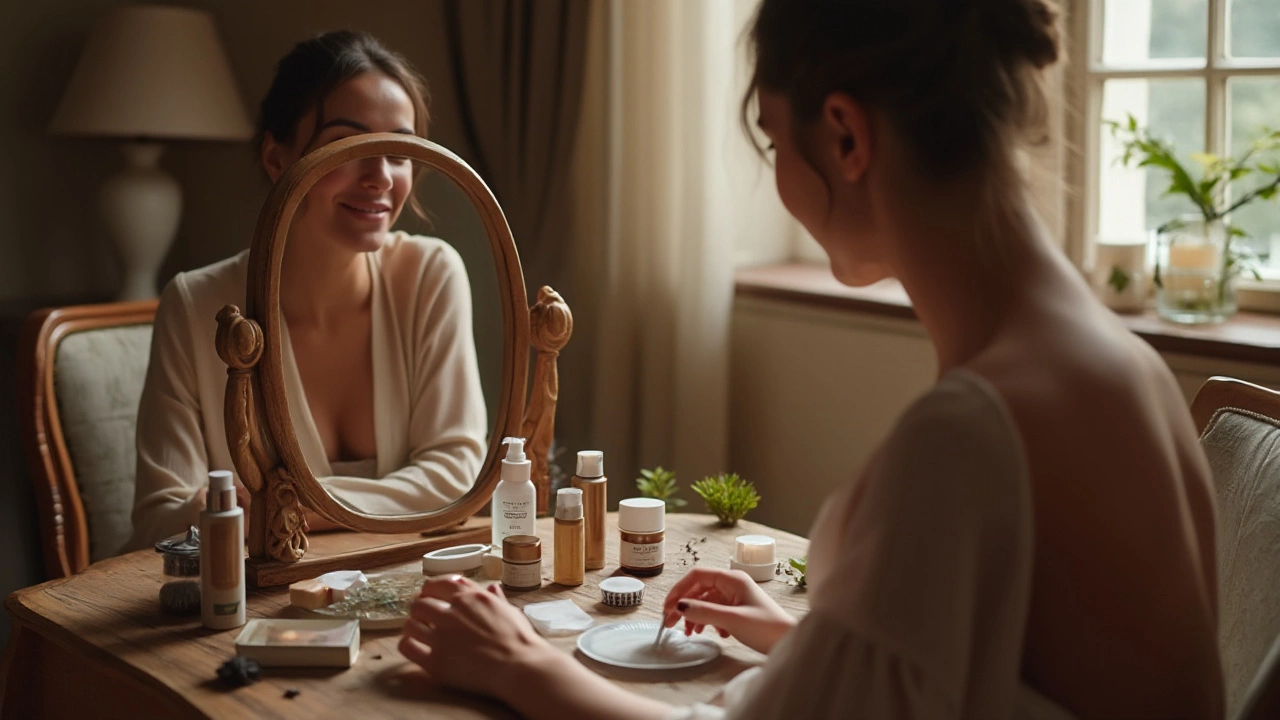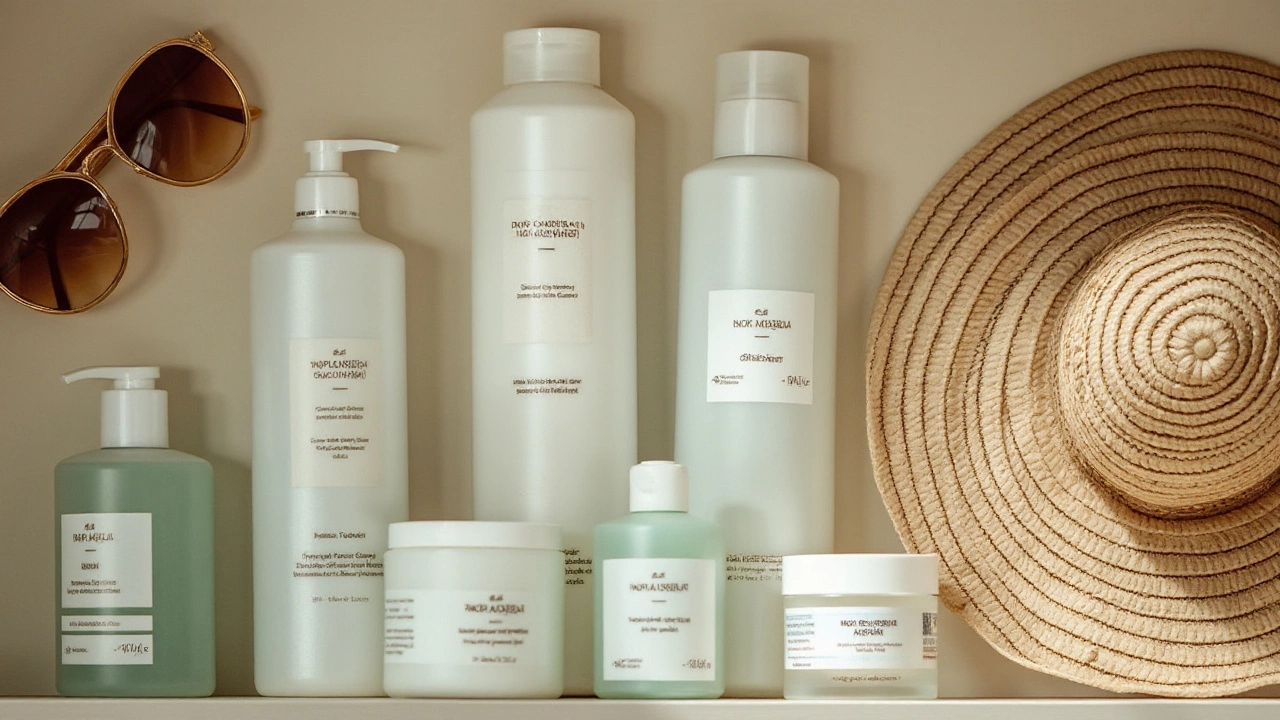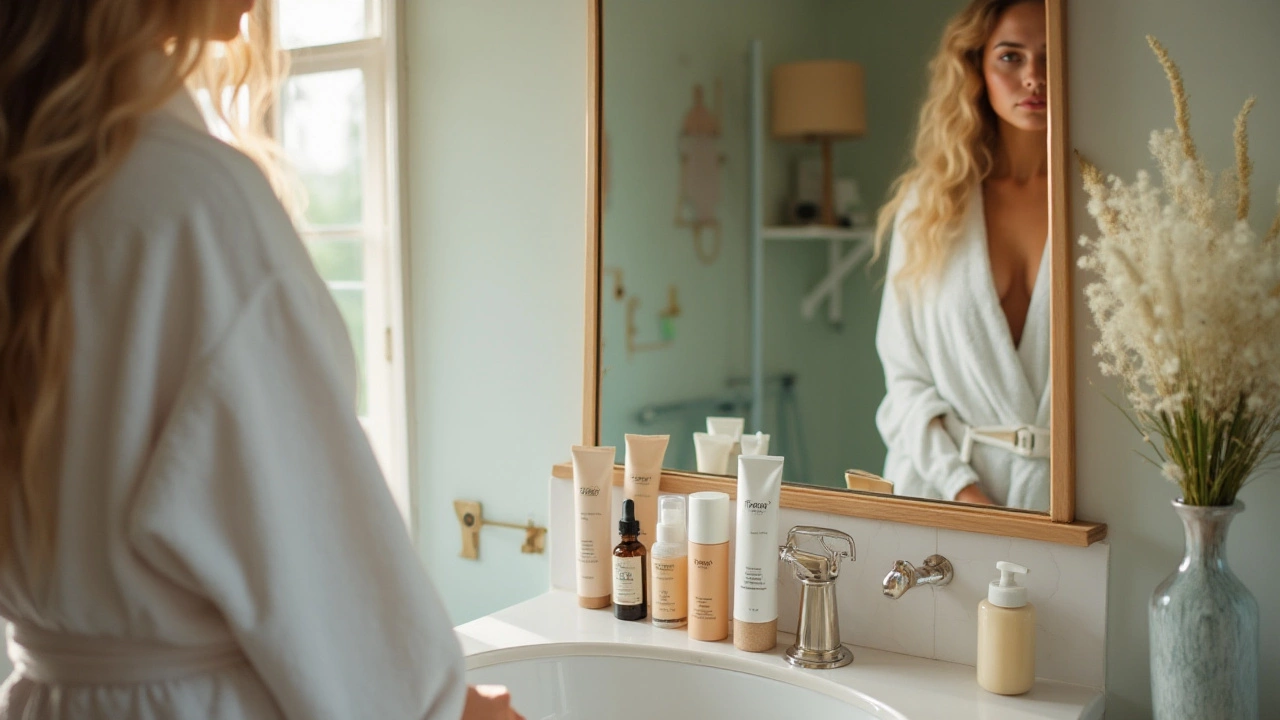Discovering the path to radiant and healthy skin can feel overwhelming when you're just starting out. Yet, with a simple and consistent skincare routine, achieving a glowing complexion is well within reach. Understanding the basics is crucial as these first steps will serve as the foundation for your future skincare endeavors.
Whether you're a novice or looking to refine your approach, grasping how your skin behaves, recognizing its specific needs, and picking the right products can make all the difference. Dive into this guide to learn the essentials that will set you on the right track for years to come.
- Understanding Your Skin Type
- The Basic Skin Care Steps
- Choosing the Right Products
- Common Mistakes to Avoid
Understanding Your Skin Type
Understanding your skin type is the cornerstone of creating an effective skincare regimen. Without knowing whether your skin tends to be oily, dry, combination, or sensitive, you may find yourself in a cycle of using ineffective or even irritating products. The skin is the body's largest organ, with functions that extend beyond appearance. It acts rightfully as a barrier against environmental harm and plays a vital role in regulating body temperature through sweat production, which also contributes to keeping your skin in balance.
In beauty terms, understanding your skin type allows you to select the right cleansers, moisturizers, and treatments specifically tailored for your unique needs. For those with oily skin, the sebaceous glands produce more oil than necessary, often leading to a shiny appearance and a greater propensity for acne. On the other hand, dry skin lacks the oil necessary to maintain balance, resulting in flaking, itchiness, and tightness. This condition is even more prevalent in harsh climates, such as the cold of January winters. Combination skin is where a person experiences both oily and dry areas simultaneously, often in the familiar 'T-zone' pattern. Lastly, sensitive skin tends to react quickly to certain substances, resulting in rashes or irritation. A wise dermatologist once noted, "Your skin is the result of your lifestyle choices." Don't these words ring especially true when acknowledging how diet, hydration, and stress levels impact your skin's behavior?
To determine your skin type at home, try the following simple experiment. Start by washing your face with a gentle cleanser, then avoid applying any products for an hour. Examine the natural state of your skin throughout this time. If your skin surfaces as shiny or feels slick, you have oily skin. If it becomes tight or scaly, dry skin could be your type. Should you notice areas of sheen alongside patches of dryness, it is most likely combination skin. For those experiencing visible redness or sensitivity, consider sensitive skin as your type. Jot down these observations for a head start in tailoring your routine. You can back up these findings with a visit to a dermatologist for professional insight, supplementing your personal study.
With an estimated 50 million people in the U.S. affected by acne each year, understanding the skin's behavior isn’t merely for cosmetic purposes; it's a matter of comfort and health. Remember, every skin care routine should start with grasping what your skin genuinely needs. It'll be your compass for selecting products that nourish, heal, and enhance your complexion.

The Basic Skin Care Steps
Diving into the world of skincare might feel like unraveling a profound mystery, yet building up a basic routine is surprisingly straightforward. A prudent starting point is to comprehend the core steps that set the groundwork for a healthy habit. Each step isn't just a ritual; it's like nurturing a relationship with your skin, which can lead to rewarding results over the long term. Experts agree that the ultimate goal is to create a consistent, reliable framework that provides the skin with what it needs, when it needs it. Think of these steps as partners in crime fighting together against grime, sun damage, and premature aging.
Cleansing
Without a doubt, the first and arguably the most crucial step in any skincare routine is cleansing. It helps you rid the skin of impurities that might clog pores or lead to breakouts. Dermatologists suggest utilizing a gentle cleanser that matches your skin type, whether it's oily, dry, or a combination. Many suggest double cleansing in the evening, especially if you've been wearing makeup or sunscreen. This simply means using an oil-based cleanser followed by a mild, water-based one. By starting with a clean slate, you give your skin a fresh canvas to absorb the rest of your routine effectively.
“Healthy skin is the key to retaining a youthful appearance,” mentions Dr. Samantha Tamlin, a well-known dermatologist, emphasizing the importance of cleansing as a daily ritual.
Exfoliating
Exfoliation is like giving your face a tune-up, sloughing away those dead skin cells that might dull your complexion. However, it's crucial not to overdo it—twice a week is typically sufficient to achieve that balanced glow. There are physical exfoliants, like scrubs, and chemical exfoliants, such as AHAs and BHAs, which break down the bonds of dead cells gently. Take care with this step as it's easy to strip the skin and cause irritation; thus, choose products tailored for beginners and always follow with a moisturizer to replenish the skin. Proper exfoliation can also enhance the potency of your skin care routine, making sure the subsequent products penetrate well.
Moisturizing
Nurturing your skin with a good moisturizer is like giving your face a comforting embrace. Regardless of your skin type, hydration is pivotal as it helps maintain the skin's barrier. Look for a moisturizer suited for your skin needs—lightweight gels for oily skin, rich creams for dry skin, and something in between for combo skin types. Moisturizers come fortified with ingredients like ceramides which strengthen the skin's outer layer. Proper hydration can result in a more plump, luminous-looking complexion that doesn’t just feel great, but also appears healthier and more resilient against environmental aggressors.
Sun Protection
No comprehensive skincare routine is complete without sun protection. The damage that UV rays can inflict is profound enough to fast forward the aging process if ignored. Dermatologists recommend a broad-spectrum sunscreen with at least SPF 30 as the final step in your daytime skincare routine. Make sure you're applying it liberally and reapplying throughout the day, especially if you're outdoors. Countries near the equator or individuals with lifestyles that involve lots of outdoor activities may need a higher SPF for adequate protection. Admiring the sunshine while protecting your skin can coexist, as long you're diligent about this key step.
If these essential steps are integrated and followed diligently, you'll find your skin reacting more positively, leading to the healthy, vibrant complexion so many of us seek. Don't rush the process—let the ritual of your skincare steps be a gentle yet efficient armor for your skin.

Choosing the Right Products
Embarking on a skincare journey means staring down the aisles of countless products, each promising the moon and the stars for your skin. But not every shiny bottle or promising label is the right match for your skin's needs. Knowing how to cut through the noise is essential for building a skincare routine that works for you. First up, familiarize yourself with the must-have components in a skincare routine. From cleanser to moisturizer, prioritize the essentials that address your specific skin concerns. A simple start might focus just on these basics before layering in more complex treatments. Begin with a night cream if you're dealing with dryness, or include a targeted serum if breakouts trouble you often. But remember, less is often more as you figure out what your skin responds to best.
One key step to demystify the product selection process is to determine and understand your skin type. Be it oily, dry, sensitive, or combination, each has its own unique demands. Generally, those with oily skin types benefit from gel-based products which provide essential hydration without clogging pores. Contrastingly, those with dry complexions might consider cream-based formulas that offer deeper nourishment. Sensitive skin often responds well to gentle, fragrance-free items formulated to minimize irritation. For combination skin, mixing and matching might be your saving grace — yes, it’s okay to use different products on your T-zone versus your cheeks. This simple curation based on skin type can be a gamechanger, as it helps your skin to feel balanced and cared for without overwhelming it.
Navigating the world of skincare ingredients feels like learning a new language, with terms like hyaluronic acid, retinoids, and peptides thrown around like a secret code. So, let's unravel them. Hyaluronic acid, known for its super hydrating powers, suits virtually any skin type by attracting moisture and locking it in. Retinoids, derivatives of Vitamin A, are heralded as miracle workers for boosting collagen and fighting signs of aging, though sensitive skin types should approach these with care. Peptides serve as the handy builders that signal your skin to produce collagen, giving your face a firmer appearance. But the golden rule is patch-testing any new product to observe your skin's reaction and sidestep possible irritation or allergies. As skincare expert, Caroline Hirons, suggests:
“Less is more. Too many actives can overwhelm the skin and be counter-productive.”
Don't forget to consider the role of seasonality in your skincare choices. Much like switching your wardrobe with the weather, your skin might appreciate small adjustments to the products you use. In humid summers, lightweight skincare products can prevent congestion, while in the chilly winters, richer, creamier textures keep your skin from feeling parched. And beyond weather, lifestyle changes such as diet, stress levels, and sleep quality also affect how responsive your skin will be to the products you choose. Keeping an eye on these factors ensures you're always in tune with what your skin truly needs, rather than a one-size-fits-all mentality.
Lastly, it's crucial to understand that patience is a virtue in skin care; results don't appear overnight. Delve into the practice of maintaining a product log, where you jot down observations about your skin's progress as you introduce new elements into your routine. This self-made journal becomes an invaluable tool for detecting what your skin loves and leans away from. By tracking changes over weeks, you can notice delayed reactions or emerge confidently assured in the decisions you’ve made. Stay committed and remember, this isn't just about finding perfect skin, it’s about nurturing what you have to the best it can be.

Common Mistakes to Avoid
Embarking on establishing a skin care routine often comes with its share of missteps. While trial and error is part of the learning curve, being aware of potential pitfalls can save both time and effort. One of the most prevalent errors is using products that are not suited for your skin type. For instance, individuals with oily skin might gravitate towards products that are overly harsh in an attempt to minimize oil, leading to increased production when skin is stripped of its needed moisture. Conversely, using heavy, creamy products designed for dry skin on a combination or oily complexion can result in clogged pores and breakouts. Knowing your skin type is crucial and serves as the foundation of a successful routine.
Another commonly overlooked mistake lies in the incorrect assumption that more products equate to better results. This especially traps beginners who are enthusiastic about embarking on their skincare journey. The skin can become overwhelmed when too many products are used simultaneously, leading to irritation and compromised skin barriers. It is recommended to integrate new products slowly, allowing your skin to adapt one product at a time. Patience is your ally, and observing how your skin reacts requires attention. Measuring your skin’s reaction before adding more elements to the routine ensures you won’t end up wondering which product is behind unexpected redness or breakouts.
A critical yet often neglected component is adequate sun protection. It's no secret that exposing your skin to UV rays without sunscreen can lead to premature aging and increase skin cancer risk. Yet, sunscreen is still one of the most skipped steps in both basic and advanced skincare routines. Even on cloudy days or during the winter months, harmful UV rays can penetrate clouds and windows. Dermatologists consistently stress this point.
“Sunscreen is the most important skincare product you’ll ever use. If you could only choose one, let it be this,” advises Dr. Jane Wu, board-certified dermatologist and author of 'The Skin Solution'.Selecting a broad-spectrum sunscreen with at least SPF 30 is advisable, and reapplying every two to three hours enhances its effectiveness.
The habit of over-exfoliating appears more frequently as a complication of overzealous attempts to maintain soft, smooth skin. While exfoliating is an essential part of nurturing a glowing complexion, going overboard can lead to irritation and an inflamed appearance. Moderation is vital, and experts usually recommend limiting exfoliation to once or twice weekly, depending on skin sensitivity. A gentle approach provides balance without compromising the protective barrier that maintains moisture levels.
Incorporating basic skin care steps in the correct order is another hurdle many face. Applying products in the wrong sequence can diminish their effectiveness. The general rule of thumb is to apply the lightest consistency first, progressively transitioning towards thicker formulations. Starting with a gentle cleanser, followed by a toner, treatments like serums, and finishing with a nourishing moisturizer, aids in layering that works harmoniously with the skin's natural processes. And don't forget that little pause between applications allows each product to absorb effectively.
Lastly, overlooking diet and lifestyle factors is often seen among beginners who focus solely on topical treatments. Proper hydration and a balanced diet enriched with vitamins and antioxidants can celebrate the natural beauty of your skin from the inside out. Aim for balance, as stress levels, sleep patterns, and nutritional intake all play pivotal roles in the appearance of the outer layers of your skin.
